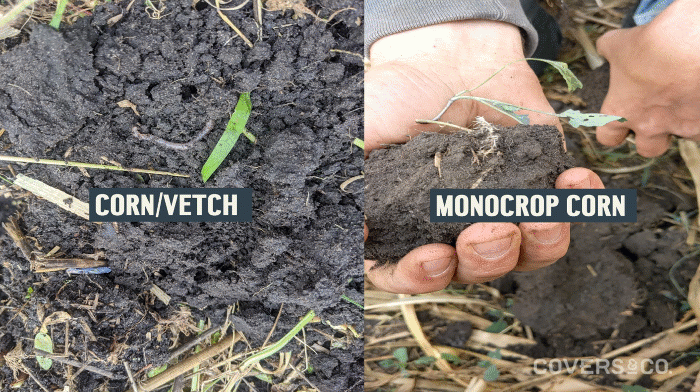Corn/Vetch Intercrop
Connecting Farmers To Soil Health
Hello, Friends.
Today, we wanted to highlight and share our experience with the intercrop of corn & hairy vetch. (we feel this is the intercrop with the easiest adoption and highest chance of success)
Balanced C:N Ratio
Corn: Warm Season Grass
Hairy Vetch: Cool Season Legume
The warm-season corn provides a micro-climate for the cool-season vetch. The vetch protects the soil and provides late-season nitrogen for the corn. Both of these species are mycorrhizal dependent and utilize each other’s root systems to share minerals and water. In other words, these plants are collaborating with one another, not competing.
The vegetative vetch (low C:N) balances the high carbon corn (high C:N). This provides an ideal environment for soil microbes to thrive. (24:1)
This is highly palatable cattle feed for of the same reason. (balanced energy & protein)
Corn/Vetch
General Information
Seeding Information: 8 Ibs per acre ($16) of Vetch was sown with air-seeder May 30th. 80 Ibs of Nitrogen was mid-row banded at the same time.
Corn was sown the following day with a 30-inch corn planter. (trials with 60-inch)
Herbicide Information: Pre-emerge glyphosate was sprayed. 1 pass in crop glyphosate @ 170 grams/acre. A second pass at the same rate was sprayed on half the field. (vetch can tolerate glyphosate sprayed at low rates. Sets it back, does not kill it) The vetch that had two passes of glyphosate was no lesser in biomass than the vetch that had 1 pass. Also had fewer weeds.
corn/Vetch
Seeding direction
An observation we have made over the past 3 years of intercropping corn & vetch, the ideal direction to seed is North/South. In the heat of the day, sunlight is able to penetrate down the North/South rows providing the vetch with enough sunlight to propagate but stay vegetative.
Both of these photos were taken at 1:30 pm.
You can see how the sunlight is able to reach the vetch below the corn canopy in the photo on the left. The photo on the right, the row direction is East/West where sunlight is less able to reach the soil surface, limiting vetch growth.
North/South Seeding Direction
East/West Seeding Direction
Corn/Vetch
60-inch Trial
Some very interesting results from our 60-inch trial. As you see from the photos below, we have accumulated a significant amount of vetch biomass.
The 60-inch trial showed a lot of promise, it will be hard not to sow all our corn in 60-inch rows next year.
The grain yield on the corn will be reduced due to the wider rows but the conditions created for the vetch are ideal leaving massive amounts of balanced grazing for our cattle.
Corn/Vetch
Harvest plan
The plan for the corn: the corn was planted on June 1st and therefore, would be tough to take dry. The plan is to harvest wet corn and ensile for winter feed.
The plan for the vetch/corn stover: we will split the field into two paddocks to keep the cows from grazing all the vetch. (35 acres each) and will likely start grazing on December 1st. (depending on snowfall)
With vetch biomass and corn stover, we are hoping to get between 100-150 cow grazing days per acre.
Corn/Vetch
Grazing Value
**assuming the price of dry hay is $0.075/Ib
It costs $2.70/cow/day.
100 grazing days per acre = $270/acre
corn/vetch
The soil benefits
As mentioned in the start of this email, having the vegetative vetch & high carbon corn creates a soil environment idea for microbial activity (24:1). With more microbial activity comes:
Stable Soil Aggregates
Increased Water Infiltration/Holding Capacity
Increased Pore Space
Compaction
An ideal environment for all soil biology (especially mycorrhizal fungi).
Infiltration Rates
Area Average: (all crops)
1st inch: 50-60 minutes
2nd inch: 2-12 hours
Corn Silage:
1st inch: 55 minutes
2nd inch: ~12 hours
Corn/Vetch
1st inch: 2 minutes
2nd inch: 22 minutes
To learn more about the water infiltration protocol and this benchmarking process, click here.
Thanks For Reading
To learn more about how we can help incorporate plant diversity into your operation:
Intercrop Library. Click here
Full Season Cover. Click Here
Warm Season Cover. Click Here
Fall Seeded Cover (Silage). Click Here
Fall Seeded Cover (Grain). Click Here
With Gratitude,
Covers & Co. Team
Joseph Gardiner, Travis Avery, Mark Fallis, Owen Taylor










